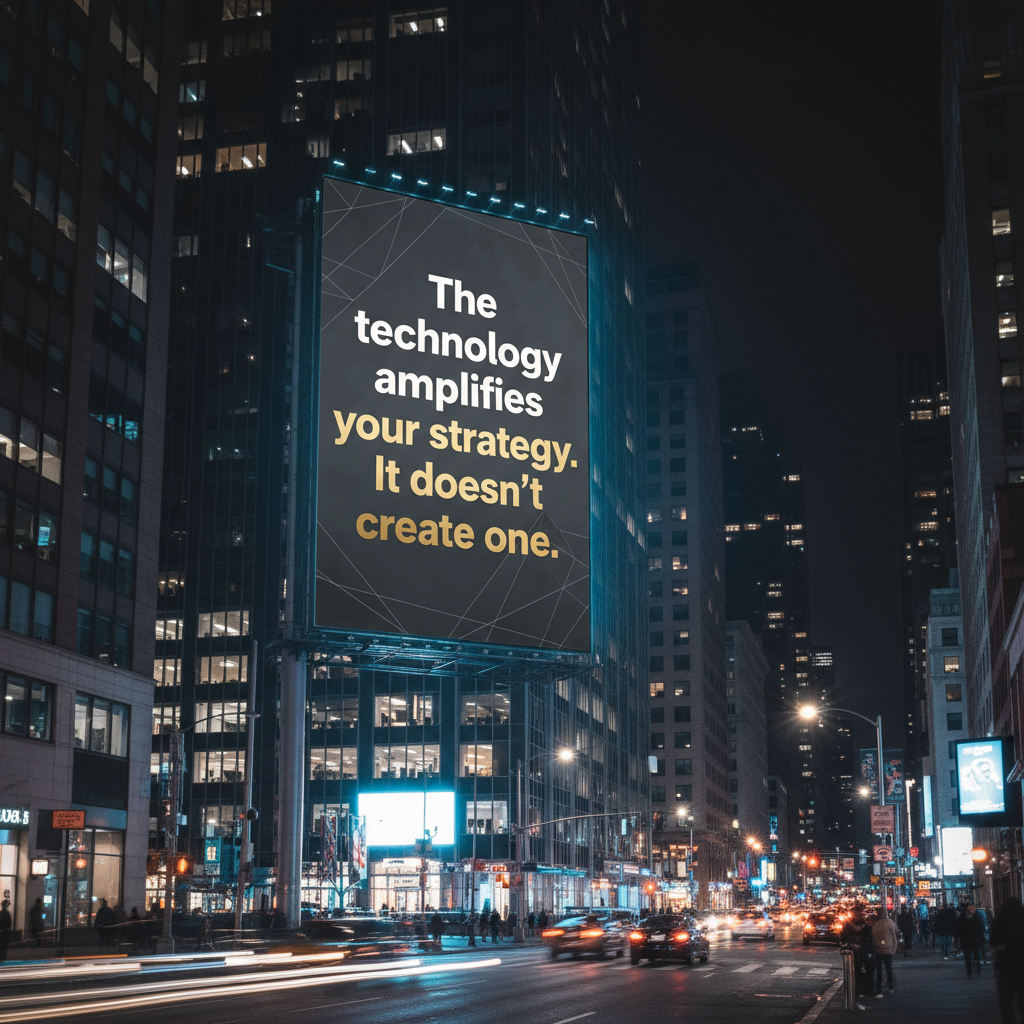
Your Competitors Are Already Using AI. Here's Why That Matters Less Than You Think
The data on AI adoption tells an interesting story.
Fifty-seven per cent of U.S. adults now use generative AI tools. Millennials lead the charge with 52% using AI at work. Baby Boomers remain hesitant, citing privacy concerns and reliability issues.
But here's what the headlines miss: adoption rates mean nothing if you're adopting the wrong things.
This pattern repeats with every new technology wave. The businesses that win aren't the early adopters. They're the focused adopters.
The Real Divide Isn't Generational
The conversation around AI adoption focuses on age. Millennials embrace it. Gen X tests it cautiously. Boomers resist it.
That's surface-level analysis.
The actual divide sits between businesses that understand their purpose and businesses that chase tools. I see this daily with SMB owners. They ask me which AI tools they should use before they've identified which problems need solving.
The data supports this. Sixty-two per cent of businesses that don't use AI cite lack of understanding as the primary barrier. Not cost. Not complexity. Understanding.
They don't know what AI should do for them.
What the Productivity Numbers Actually Tell Us
Workers using generative AI show 33% higher productivity per hour. The least-skilled users see the biggest gains, with performance improvements of 66% on average.
These numbers look impressive until you apply the 80/20 principle.
If AI improves productivity by 33%, you need to ask: productivity at what? Because 33% faster execution of the wrong tasks just means you're wasting time more efficiently.
Small businesses already spend five hours or less weekly on marketing. Adding AI to that limited time only helps if you're focused on the 20% of activities that drive 80% of your results.
The technology amplifies your strategy. It doesn't create one.
Why 68% Adoption Doesn't Mean What You Think
Sixty-eight per cent of small business owners now use AI. Another 9% plan to start within the year. These numbers suggest a massive shift.
But adoption without implementation is just expensive experimentation.
I work with service businesses generating between $1 million and $10 million annually. Most of them have tried AI tools. Few have integrated them into systematic workflows that produce measurable results.
The gap between "using AI" and "getting results from AI" comes down to understanding what to automate. Automation executes strategy. It requires you to know which tasks matter and which tasks just fill time.
Seventy-five per cent of SMBs are experimenting with AI. Only 52% are training their employees to use it properly. That gap explains why so many businesses feel overwhelmed rather than empowered by new technology.
The Pattern That Predicts Success
High-growth companies make faster decisions by evaluating fewer variables. They don't analyse every option. They establish clear criteria, then move.
This applies directly to AI adoption.
The businesses seeing real results from AI aren't using every available tool. They've identified the specific bottlenecks in their operations, then deployed AI to address those specific problems.
One client in the education sector used AI to automate their follow-up sequences. Not because automation was trendy. Because they identified that 80% of their revenue came from prospects who received consistent follow-up within 48 hours.
They automated that one process. Revenue increased. Time freed up for higher-touch client interactions.
That's focused adoption.
What the Next Three Years Look Like
Ninety-one per cent of SMBs using AI report revenue increases. Eighty-seven per cent say it helps them scale operations. Eighty-six per cent see improved margins.
These numbers will improve as the technology matures and businesses learn what works.
But the fundamental principle won't change: AI amplifies what you're already doing. If your marketing lacks strategy, AI will help you execute that lack of strategy more efficiently. If your systems create confusion, AI will automate that confusion at scale.
The businesses that will dominate their markets over the next three years aren't the ones adopting AI fastest. They're the ones who:
Identify their core revenue drivers using the 80/20 principle
Build systematic processes around those drivers
Deploy AI strategically to execute and scale those processes
Train their teams to work alongside the technology
Measure results and adjust based on data
The Privacy Question Nobody's Answering
Sixty-nine per cent of business leaders cite AI data privacy concerns. Seventy-three per cent worry about security risks. These concerns increased significantly from Q4 2024 to Q2 2025.
The concerns are valid.
But they're also being used as excuses for inaction. I've watched business owners delay technology decisions for years, citing security concerns, whilst their competitors capture market share using those same tools.
The solution isn't to ignore privacy and security. It's to understand them well enough to make informed decisions. Work with platforms that prioritise data protection. Read the terms of service. Ask questions about how your data gets used.
Then make a decision and move forward.
One in three small businesses continually delay technology investment. That delay costs them more than any security breach ever could, because whilst they're planning, their competitors are executing.
What You Should Do Tomorrow
Stop thinking about AI adoption as a binary choice. You don't need to embrace every AI tool or reject them all.
Start here:
Map your revenue sources. Identify which 20% of your activities generate 80% of your results.
Find the bottlenecks. Where do tasks pile up? Where do opportunities slip through? Where does your team spend time on repetitive work?
Choose one process to automate. Not ten. One. Pick the bottleneck that, if removed, would free up the most time or capture the most revenue.
Implement it properly. Train your team. Test the system. Measure the results.
Then repeat.
The businesses winning with AI aren't using it everywhere. They're using it strategically in the places that matter most.
That's not a generational advantage. That's a strategic one.
And it's available to you right now, regardless of your age, your technical skill, or your current adoption rate.
The question isn't whether you should use AI. The question is whether you understand your business well enough to know where AI can help.
Answer that question first. The technology decisions become simple after that.
https://www.pymnts.com/study_posts/generation-ai-why-gen-z-bets-big-and-boomers-hold-back/





